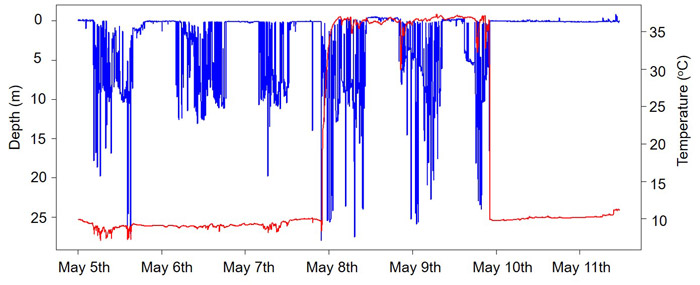Reports on behaviour and survival of fish residing at sea are scarce and often recapture-based. By tagging 125 sea trout kelts with positively buoyant DSTs, we were able to compare the behaviour in fish that survived the marine period with fish that had migrated to sea and died there. This provided new insights to the ecology of the species.
Sea trout is a widespread species, capable of adapting to local conditions and utilizing both fjords, coastal areas and open seas during its marine migration. Studies with acoustic telemetry are beginning to unravel the behaviour of sea trout in fjords and estuaries, but as with many other species, knowledge regarding behaviour of individuals utilizing open seas and coastal zones remains scarce.

We therefore tagged 125 Danish sea trout kelts with positively buoyant DSTs. Fifty-three tags (42 %) were recovered, of which 33 were from kelts that had made it to sea. Eight of these individuals had survived the entire marine period while 25 had died at sea. The kelts that died at sea were of similar length but had lower weight/length ratios when tagged than the surviving kelts (P = 0.005).
Data suggested the first three weeks after entering the sea were critical for the kelts. The mean survival time was 14.3 days (range 1–65 days) for the 21 recorded natural mortalities and only two natural mortality events were recorded after the fish had spent three weeks at sea. In addition to the natural mortalities, four individuals had died as a consequence of recreational angling from the coast. Mortality events were recorded throughout the day with a skew towards higher mortality during crepuscular hours.
Both surviving and non-surviving kelts initiated a characteristic diving behaviour after reaching the sea. The fish dove frequently to depths deeper than 5 metres (maximum recorded depth was 88 m) and resided at the surface during nighttime. Both surviving and non-surviving fish gradually increased diving activity and the daily visited maximum depths, but surviving fish were more active than non-surviving fish in terms of diving activity. This was particularly the case when comparing with non-surviving fish caught by recreational anglers from the coast. These fish had also preferred residency on shallower depths before being caught.
The results provide valuable experience with using positively buoyant DSTs on salmonids and exemplify how this technique can be used to gain new insights to the ecology of marine fish. The results show that the first weeks at sea are critical for kelt survival and that physical status of kelts may affect behaviour and probability of survival. The preference for shallower waters and less diving activity in some individuals indicate that coastally based fisheries and recreational angling may select against specific behavioural phenotypes which should be investigated more intensively.
Behaviour of adult sea trout Salmo trutta that survive or die at sea
Detailed reports on behaviour in sea trout kelts surviving the marine period
Af Martin Lykke Kristensen, Henrik Baktoft, Finn Sivebæk og Kim Aarestrup, DTU Aqua, Institut for Akvatiske Ressourcer.